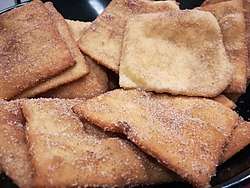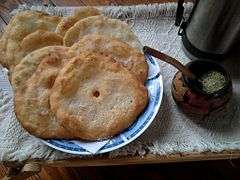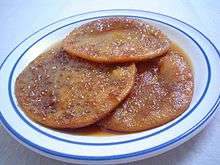Sopaipilla
A sopaipilla, sopapilla, sopaipa, or cachanga[1] is a kind of fried pastry and a type of quick bread served in several regions with Spanish heritage in the Americas.[note 1] The word sopaipilla is the diminutive of sopaipa, a word that entered Spanish from the Mozarabic language of Al-Andalus.[9] The original Mozarabic word Xopaipa was used to mean bread soaked in oil. A similar word exists in Hebrew, "copaiba", as this was brought to Northern New Mexico by the Ladino-speaking crypto-Jews who first settled there and laid the foundation for the unique dialect of New Mexican Spanish. The word is derived in turn from the Germanic word suppa, which meant bread soaked in liquid.[2]
 New Mexican dessert sopaipillas | |
| Main ingredients | Leavening agent, wheat dough (or wheat flour and masa harina), shortening or butter |
|---|---|
| 4 kcal (17 kJ) | |
A sopaipilla is traditionally made from leavened wheat dough (or a mixture of wheat flour and masa harina) to which some shortening or butter is added. After being allowed to rise, the dough is rolled into a sheet that is then cut into circular, square or triangular shapes. The shapes are 8–10 cm in size for the longest dimension (if intended for a dessert) or 15–20 cm (if intended to be stuffed for a main course). The shapes are then deep-fried in oil, sometimes after allowing them to rise further before frying: the frying causes the shapes to puff up, ideally forming a hollow pocket in the center.[10]
Variations
Argentina

In Argentina, pastry is known under other names apart from sopaipa, supaipa and sopaipilla; other names include Torta frita, Kreppel, and chipá cuerito.[2]
Chile

In Chile, sopaipillas (or sopaipas) are known to have been eaten at least since 1726.[9] Although Traditional Chilean sopaipillas (made in the central part of Chile) include cooked ground pumpkin in their dough, this is typically not the case in the South of Chile.[2] Depending if they are served as a pastry or bread Chilean sopaipillas are traditionally served with either pebre (a sauce of chili pepper, onion, garlic and coriander) or boiled in chancaca sauce (a homemade hot syrup cooked with panela, orange peel and cinnamon, and then they are called sopaipillas pasadas). They are also served with mustard, ketchup, hot butter, avocado or cheese.[2][3][9] In Chile sopaipillas are traditionally homemade and eaten during days of heavy rain,[2] as well as enjoying widespread popularity as street food. Chilean sopaipillas are round and flat, sporting holes pricked through the centre of the dough, usually by a fork.


In Chiloé Archipelago and neighbor zones, sopaipillas have rhomboid form, they are usually sweet and served with jam or honey. They are a relevant ingredient in reitimientos, a traditional feast related to rendering fats after a pig slaughter.
Peru
In Peru, the name for this fried pastry is cachanga, and it may be either sweet or sour.[1][11] Generally prepared during breakfast time, this traditional food of the Peruvian cuisine is prepared differently depending on the region,[11] with one of the recipes involving the usage of cinnamon.[1] The main difference between this form of sopaipilla and the other versions is that they are larger, thinner, and more rigid.[11]
United States
Sopapillas in New Mexican cuisine are distinct from Latin American sopapaillas. New Mexican sopapillas are pillow-shaped fried pastry dough. They are typically served as a bread, and used to mop up sauces, scoop up tidbits, or shredded into stews. In northern New Mexico, they are often filled with savory ingredients such as ground beef or chicken, covered with chili and cheese, and served with lettuce and tomato as an entree, but such "stuffed sopaipillas" are a relatively new innovation and are still fairly unknown in the southern part of the state. They are sometimes eaten as a dessert, drizzled with honey or anise syrup.[12] but are often eaten this same way during the meal itself as New Mexican cuisine tends to be very spicy and sweet syrups reduce the sensations of heat.
Sopapillas in Tex-Mex cuisine are a puffed pastry, but otherwise similar to New Mexican-style sopapillas, except that they are always served as a dessert item, coated with cinnamon sugar and served with honey.[13] Many Tex-Mex restaurants in Texas and Oklahoma will serve dessert sopapillas[14][15] as part of the complimentary "set-up": chips and salsa served before the meal, along with sometimes queso sauce, pickled vegetables and flour tortillas and sopapillas served at the end of the meal.
Sopaipilla and strudel were together designated as Texas' state pastries from 2003 to 2005.[6]
See also
- Buñuelos (Mexico)
- Mueganos (Mexico)
- Frybread
- List of quick breads
- List of doughnut varieties
- List of fried dough varieties

Notes
References
- Peru Handbook. Retrieved 26 January 2015 – via google.com.
- Correa, Adriana. Comida de larga tradición Diario de Cuyo
- Burford, Tim (March 2005). Chile: The Bradt Travel Guide. Bradt Travel Guides. p. 87.
- Chávez, Thomas E. (1 October 2006). New Mexico Past and Future. University of New Mexico Press. ISBN 0-8263-3444-X.
- Painter, Kristen (March 28, 2014). "Casa Bonita celebrates 40 years of sopapillas and cliff diving". The Denver Post. Retrieved March 30, 2014.
- "Texas State Symbols". Texas State Library & Archives Commission website. 10 August 2009.
- "Torta Frita Cuando Llueve". Montevideo.gub.uy. Archived from the original on 2011-04-26. Retrieved 2010-11-21.
- Sabor a Mexico. "Sopaipilla". saboramexico.com.mx. Retrieved 26 January 2015.
- San Juan, Verónica. "¿Por qué se llaman como se llaman?" [Why are they called what they're called?]. Revista Mujer (in Spanish). La Tercera. Archived from the original on 29 March 2010. Retrieved 21 February 2010.
- Cynthia Detterick-Pineda. Recipe: New Mexico Sopapillas. URL: http://whatscookingamerica.net/CynthiaPineda/Sopapillas/Sopapillas.htm
- llajua (25 June 2009). "Cachanga". Cookpad. Retrieved 26 January 2015.
- Casey, Clyde (October 30, 2013). New Mexico Cuisine. UNM Press. p. 60. ISBN 9780826354181. Retrieved March 4, 2016.
- Levin, Joe. "How to Make Sopaipillas". Texasmonthly.com. Retrieved 2019-08-20.
- "Sopapillas - Texas Farm Bureau - Table Top". Tabletop.texasfarmbureau.org. Retrieved 2019-08-20.
- "Sopapillas with a side of honey". Homesick Texan. 2007-01-29. Retrieved 2019-08-20.
Further reading
- Sheila MacNiven Cameron, ed. (1978). The Best from New Mexico Kitchens. New Mexico Magazine. ISBN 0-937206-00-8.
External links
- "sopaipilla", Webster's New World College Dictionary
- Chilean-Style Sopapillas, or Pumpkin Fritters from The Spruce Eats
- How to Make New Mexico Style Sopaipillas